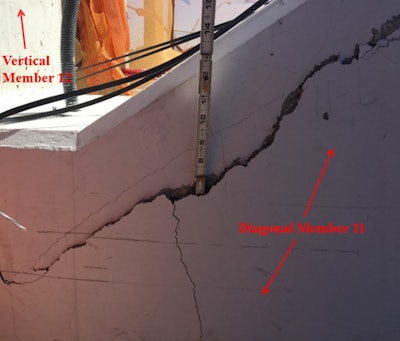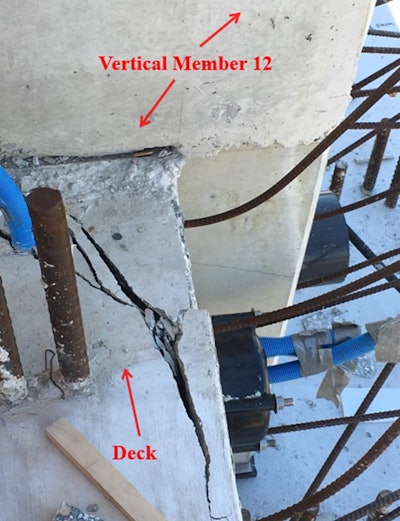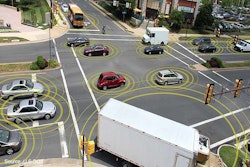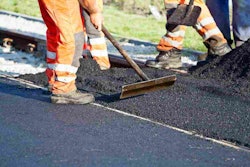 One of the cracks on truss member 11 of the FIU pedestrian bridge shown two days before the March 15, 2018, collapse in photo by contractor Munilla Construction Management, and provided by the NTSB.
One of the cracks on truss member 11 of the FIU pedestrian bridge shown two days before the March 15, 2018, collapse in photo by contractor Munilla Construction Management, and provided by the NTSB.The National Transportation Safety Board has determined that the collapse of the Florida International University Pedestrian Bridge in Miami on March 15, 2018, was probably caused by load and capacity calculation errors by engineer FIGG Bridge Group.
NTSB staff gave its probable-cause report October 22 on the collapse during a public hearing before the board, saying it was caused by design flaws by engineer FIGG Bridge Group and that later efforts by FIGG to address large cracking in the bridge led to its collapse.
It also stated that the Florida Department of Transportation, Florida International University, contractor Munilla Construction Management (which has changed its name to Magnum Construction Management), and Bolton Perez & Associates Consulting Engineers, failed in their oversight duties by not closing the road beneath the bridge or conducting proper peer review.
The findings are similar to those found by a report earlier this year by the U.S. Occupational Safety and Health Administration.
The 174-foot bridge collapsed March 15, 2018, killing six and injuring 10 people below. Three weeks before the collapse, large cracks began to show on the bridge’s truss member 11 during construction. NTSB staff said those cracks should have been recognized as abnormal, as they were as wide as 3/4th of an inch and were 40 times larger than acceptable. It was evident the structure was failing, NTSB said.
Overestimating load, underestimating capacity
 Another crack on truss member 11 of the FIU pedestrian bridge shown two days before the March 15, 2018, collapse in photo by contractor Munilla Construction Management, and provided by the NTSB.
Another crack on truss member 11 of the FIU pedestrian bridge shown two days before the March 15, 2018, collapse in photo by contractor Munilla Construction Management, and provided by the NTSB.In designing the bridge, NTSB said, FIGG had overestimated member 11’s capacity and underestimated the load by choosing the wrong load factor.
Though FIGG did not know the cause of the cracking, it decided to retension post-tension bars for truss member 11. It had also assured stakeholders in the bridge project that the bridge was safe, just hours before its collapse.
Failed oversight
 Main span being moved on March 10, 2018, prior to placement on the south pier and north pylon pier, looking to the west. (Labels added by the NTSB; photo part of NTSB report.)
Main span being moved on March 10, 2018, prior to placement on the south pier and north pylon pier, looking to the west. (Labels added by the NTSB; photo part of NTSB report.)The retensioning of member 11 pushed the concrete beyond its limits and caused it to fall and push through the bottom of member 12, NTSB staff said. The 950-ton bridge fell 18.5 feet, crashing into eight cars below.
It also noted that because the retensioning was a design change, it should have been reviewed, signed and sealed by a professional engineer, which did not occur.
NTSB reports that the project also violated FDOT rules requiring an outside, independent engineer to review the design throughout the stages of construction.
FIGG designated the peer review to be done by an independent department within the firm, NTSB said. It wasn’t until later into the project that FIGG hired professional services firm Louis Berger to conduct a review. However, Berger was not prequalified by FDOT to perform the independent review, and the firm also lacked the required experience, NTSB staff said.
Berger had not analyzed the design through the different stages of the project, saying it would have exceeded the budget and required more time, according to NTSB. NTSB said this was a failure of FIGG’s to not meet FDOT requirements and was a failure of FDOT’s oversight by not determining Berger was not qualified to conduct the review. This allowed significant errors in FIGG design to go undetected, NTSB said.
Road left open
 Crack by truss member 12 of the FIU pedestrian bridge shown two days before the March 15, 2018, collapse in photo by contractor Munilla Construction Management, and provided by the NTSB.
Crack by truss member 12 of the FIU pedestrian bridge shown two days before the March 15, 2018, collapse in photo by contractor Munilla Construction Management, and provided by the NTSB.NTSB staff also noted that at a March 15, 2018, meeting in which the cracks and retensioning were discussed, none of the other parties – FDOT, FIU, MCM nor Bolton Perez – exercised their authority to close the road beneath the structure.
It also said FDOT should have provided more oversight because of the bridge’s unique and complex design. Reinforced-concrete truss bridges are rare, with trusses typically constructed of steel, making the FIU design unique. From its review, NTSB recommends that national and state guidelines be created on redundancy for uncommon bridges that include concrete structures. Redundancy is the ability of a bridge to continue to carry loads after the damage or failure of one or more of its members.
However, NTSB said that concrete and steel used to build the bridge were not a factor in the collapse.
FIGG, FDOT respond
FIGG Bridge Engineers released the following statement regarding the NTSB board meeting:
“At the NTSB meeting today, it was evident that the investigation into the FIU pedestrian bridge construction accident presented challenges for the agency to accurately understand all of the technical and factual components. The accident was the result of a complex series of events and failings by parties at multiple stages of the project.
“An analysis conducted by Wiss, Janney, Elstner Associates (WJE), the country’s preeminent forensic structural engineering firm, proved that if the construction joint at member 11 had been built as required by Florida Department of Transportation (FDOT) Standard Construction Specifications, the construction accident would not have occurred.
“WJE has worked with the government on numerous forensic investigations in its 60-year history such as the 2007 collapse of the I-35W Mississippi River Bridge in Minneapolis. In its review of the FIU pedestrian bridge accident, WJE conducted detailed research, in-depth analysis, and physical testing. When the Federal Highway Administration (FHWA) Turner-Fairbank Highway Research Center issued its October 19, 2018 analysis concluding that the concrete cold joints were not intentionally roughened, WJE went a step beyond analysis and performed testing of full-scale replicas of the critical connection with both roughened and un-roughened surfaces. WJE’s tests revealed, contrary to the findings of the NTSB, that the failure to roughen the concrete beneath bridge member 11 was the fundamental cause of the collapse.
“FIGG Bridge Engineers, Inc. looks forward to an opportunity to discuss WJE’s findings with FHWA.”
And FDOT Secretary Kevin J. Thibault released the following statement October 22:
“The events surrounding the FIU bridge collapse are absolutely heartbreaking for both the families and loved ones of the victims, but also for the community and state. The Department has and will continue to cooperate fully with the NTSB as part of this process and has already implemented many of the improvements discussed today. I remain committed to ensuring that all NTSB recommendations are followed so a tragedy like this never happens again in Florida.”
NTSB recommendations
 Crack near truss member 12 of the FIU pedestrian bridge shown one day before the March 15, 2018, collapse in photo by contractor Munilla Construction Management, and provided by the NTSB.
Crack near truss member 12 of the FIU pedestrian bridge shown one day before the March 15, 2018, collapse in photo by contractor Munilla Construction Management, and provided by the NTSB.In conclusion, NTSB issued 11 safety recommendations:
To the Federal Highway Administration:
- Assist the American Association of State Highway and Transportation Officials with developing a requirement that concrete bridge structures be designed with reasonable estimates for interface shear demand, the cohesion and friction contributions to interface shear capacity, and the clamping force across the interface shear surface.
To the Florida Department of Transportation:
- Revise your Plans Preparation Manual to require that the qualified independent peer review for category 2 bridge structures include checking and verifying the design calculations used for all nodal forces.
- Revise your Plans Preparation Manual to require the engineering firm or company independently peer reviewing bridge design plans to submit a prequalification letter showing that it is qualified in accordance with Florida Administrative Code Rule 14-75 before permitting the firm to sign and seal the 100 percent certification letters indicating that the bridge designs have been peer reviewed.
- Revise local agency program agreements to specify that when structural cracks are initially detected during bridge construction, the engineer of record, construction engineering inspector, design–build firm, or local agency that owns or is responsible for the bridge construction must immediately close the bridge to construction personnel and close the road underneath; fully support the entire bridge weight using construction techniques that do not require placing workers on or directly under the bridge during installation; and restrict all pedestrian, vehicular, and construction traffic on the bridge until the complete support is in place and inspected.
- To help facilitate compliance with Florida Department of Transportation standards, require your personnel to monitor and inspect all local agency program bridge projects determined by the department to have uncommon designs.
- Add a discussion about redundancy to the Structures Manual, Structures Design Guidelines, emphasizing uncommon bridge designs, as determined by the Florida Department of Transportation.
To the American Association of State Highway and Transportation Officials:
- Work with the Federal Highway Administration to develop a requirement that concrete bridge structures be designed with reasonable estimates for interface shear demand, the cohesion and friction contributions to interface shear capacity, and the clamping force across the interface shear surface.
- Add a discussion about redundancy in the design of concrete structures to section 5 of the LRFD [Load and Resistance Factor Design] Bridge Design Specifications.
- Add a discussion about redundancy to the LRFD [Load and Resistance Factor Design] Guide Specifications for the Design of Pedestrian Bridges, emphasizing uncommon bridge structures.
To FIGG Bridge Engineers, Inc.:
- Train your staff on the proper use of Pc (the permanent net compressive force normal to the shear plane) when calculating nominal interface shear resistance.
- Institute a company policy to obtain a prequalification letter before finalizing any peer review contract with any engineering firm or company being considered to conduct peer review services.
For more details on the NTSB report, click here.
NTSB says it plans to publish its full, final report in the coming weeks.











